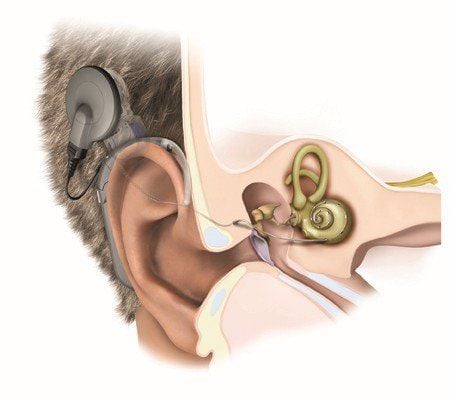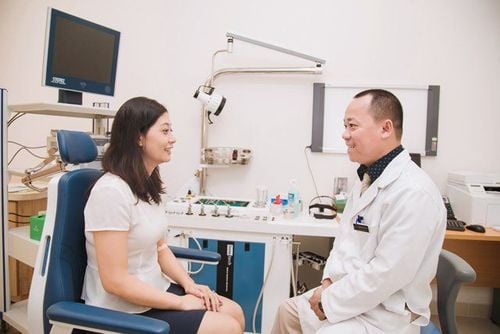This is an automatically translated article.
The article was professionally consulted with Doctor CKII Nguyen Van Thai - Department of Medical Examination & Internal Medicine - Vinmec International General Hospital Da Nang.Hearing loss is one of the sensory defects that severely affects patients. Children born deaf often lack confidence, guilt, difficult to integrate into the community. With the development of medical science, the restoration of this hearing damage by the method of cochlear implantation is a very important step forward.
1. Overview
Children with congenital deafness are often applied with many treatment measures such as exercise, wearing hearing aids.... However, for children with severe hearing loss, the above methods will not be effective. Cochlear implantation will be the last resort to help children hear sounds and improve communication.1.1 What is a cochlear implant? This is a method of using an electronic device that is an electrode implanted in the ear to replace damaged auditory nerve cells and generate nerve impulses that are transmitted to the brain, helping patients with profound hearing loss can. hearing..
1.2 Mechanism of action of cochlear implants Sound waves pass into the ear through the ear canal into the tympanic membrane, continuing into the middle ear under mechanical impact and amplifying sound.
The cochlea is located in the middle, has 3 channels. The middle channel hears organically, has hair cells for sensing. Cells are activated electromagnetic waves and follow the auditory nerve to the brain.
When the cochlear electrode is implanted, the sound is transmitted to the sound processing center and digitized, further propagated to the implanted part through an antenna. The implanted device converts digital sound into signal waves that are applied to the cochlear electrode. The electrode stimulates the auditory nerve and the decoded sound signal goes to the brain.
After implantation is complete, according to the development of the patient's hearing age, the parts will be adjusted through audiometric software to help the patient hear more clearly and clearly.

2. Indications and contraindications
Indication caseAdults and children from 1 year of age and older. People with severe and bilateral profound deafness (>80dB), the use of hearing aids is not effective. People only have damage to the cochlea, the auditory nerve functions are still normal. The person does not have an infection in the ear and mastoid bone. Normal psycho-physiological health status, willing to cooperate to practice and restore communication ability for a long time. CT Scan and MRI of the cochlea without labyrinthine ossification. Contraindications
People with active otitis media. Abnormal anatomical images of the ear will interfere with cochlear implant surgery. People with mental retardation (depending on the severity to consider surgery). People with severe accompanying medical diseases (congenital heart disease, anemia, genetic diseases, pneumonia,...).
3. Preparing for Cochlear Implant
PerformerOtolaryngologist trained in cochlear implant surgery .

Ear microsurgery instruments, electric drills with many speeds and sizes. Instruments for otoscopy. Wireless display. Nervous system VII. High magnification, adjustable surgical microscope. The camera is attached to the microscope. Patient preparation
Patients preparing for cochlear implantation need to wish to have surgery. For children over 1 year old, parents need to have a desire to implant cochlear electrodes for their children.
To prepare for surgery, the patient is tested for hearing, CT scan, magnetic resonance to detect brain damage and abnormalities of the cochlea. From there, draw conclusions about cochlear deafness. Patients themselves or their families are also well explained about possible complications during surgery and after surgery. Before surgery, the patient will be cut high and wide behind, on the earlobe to facilitate impact on this area.
4. Cochlear implant procedure
Step 1: AnesthesiaPerform general anesthesia for the patient. Injecting 2% lidocaine (may be mixed with 0.1% adrenaline) or epinephrine into the line will make an incision behind the ear or ear canal.

Make an incision behind the ear in the shape of an inverted C, U or S. To expose the temporal muscle, dissect the temporal muscle leg to create a flap that covers the inner device of the cochlea electrode. To show the mastoid surface, the temporal ridge, the spines of Henle, the mastoid process, the Chipault ethmoid area. Open the posterior wall of the external ear canal, dissect the skin of the ear canal to the level of the tympanic groove. Using an open drill into the planing pole in the Chipault ethmoid region, drill all groups of mastoid cells until the hammer anvil joint, the anterior epicardial wall, and the lower ridge of the Fallop canal can be seen. Open the posterior tympanic cavity: thin the wall of the VII nerve from top to bottom, helping to open a window from the posterior mastoid fossa to the tympanic cavity without dissection of the tympanic membrane. Using a small drill, drill the top of the ridge of the fallopian tube, directing the drill toward the tympanic cavity until the round window is clearly visible. Open the cochlea by using a diamond drill to open a small hole 0.6-1mm in front about 1mm from the circular window. Step 3: Perform cochlear implant technique
Use methylene blue to draw the electrode mold in advance. On the outer surface of the mastoid bone, the bone defect is opened to prepare the electrode body for placement. When the bone defect fits the electrode body, small holes are drilled in the corners of the bone defect, and surgical sutures are used to fix the electrode. The electrode placed in the mastoid bone usually consists of 1 electrode body, 2 electrode wires, the ground wire and the active wire. Through a special instrument, the active wire will be inserted into the cochlea through a circular window to help place the electrode deep into the cochlea. Secure the electrode with bio-glue or muscle tissue inserted into the cochlear opening. The ground wire is fixed to the bottom of the temporalis muscle. Step 4: End of surgery
Use the temporal muscle flap to cover the electrode body, aspirate and clean the mastoid fossa. The incision is sutured with 2 layers of skin sutures, and a bandage is applied. Continue to follow up with CT scan (to determine if the ear canal electrode is in the correct position or not). Instruct patients to take Cephalosporin antibiotics for 7 days in combination with analgesics and anti-edematous drugs. Requires regular follow-up visits to check the results of surgery. After 4-6 weeks when the scalp sutures have recovered to almost normal, proceed to external device placement.

5. Complications and treatment
After surgery, patients may experience mild complications such as tinnitus, dizziness, surgical site infection... or more severe complications such as peripheral facial paralysis, meningitis, and electrode drop out of the cochlea. ...There are also some other common complications such as:
Hematoma under the skin: due to poor hemostasis or secondary bleeding. If the hematoma is small, apply pressure, if there is a lot of hematoma, surgery is required to stop the bleeding. VII nerve palsy: due to edema. After anti-edema treatment, the prognosis is restored after 3-6 months. Vestibular: due to drilling into the vestibular bay of the cochlea. Treat according to the indications of drugs to enhance inner ear circulation. Infection of the surgical site: due to external factors or from mastoid fossa disease. It is necessary to appoint high-dose antibiotics, to prevent the risk of meningitis. Cerebrospinal fluid leak: due to abnormalities of cochlear anatomy. Treat in the direction of using biological glue or muscle tissue to block the fistula. Vinmec International General Hospital is a high-quality medical facility in Vietnam with a team of highly qualified medical professionals, well-trained, domestic and foreign, and experienced.
A system of modern and advanced medical equipment, possessing many of the best machines in the world, helping to detect many difficult and dangerous diseases in a short time, supporting the diagnosis and treatment of doctors the most effective. The hospital space is designed according to 5-star hotel standards, giving patients comfort, friendliness and peace of mind.
Please dial HOTLINE for more information or register for an appointment HERE. Download MyVinmec app to make appointments faster and to manage your bookings easily.














